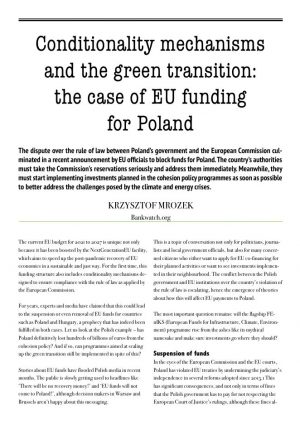 The current EU budget for 2021 to 2027 is unique not only because it has been boosted by the NextGenerationEU facility, which aims to speed up the post-pandemic recovery of EU economies in a sustainable and just way. For the first time, this funding structure also includes conditionality mechanisms designed to ensure compliance with the rule of law as applied by the European Commission.
The current EU budget for 2021 to 2027 is unique not only because it has been boosted by the NextGenerationEU facility, which aims to speed up the post-pandemic recovery of EU economies in a sustainable and just way. For the first time, this funding structure also includes conditionality mechanisms designed to ensure compliance with the rule of law as applied by the European Commission.
For years, experts and media have claimed that this could lead to the suspension or even removal of EU funds for countries such as Poland and Hungary, a prophecy that has indeed been fulfilled in both cases. Let us look at the Polish example – has Poland definitively lost hundreds of billions of euros from the cohesion policy? And if so, can programmes aimed at scaling up the green transition still be implemented in spite of this?
Stories about EU funds have flooded Polish media in recent months. The public is slowly getting used to headlines like ‘There will be no recovery money!’ and ‘EU funds will not come to Poland!’, although decision makers in Warsaw and Brussels aren’t happy about this messaging.
This is a topic of conversation not only for politicians, journalists and local government officials, but also for many concerned citizens who either want to apply for EU co-financing for their planned activities or want to see investments implemented in their neighbourhood. The conflict between the Polish government and EU institutions over the country’s violation of the rule of law is escalating, hence the emergence of theories about how this will affect EU payments to Poland.
The most important question remains: will the flagship FEnIKS (European Funds for Infrastructure, Climate, Environment) programme rise from the ashes like its mythical namesake and make sure investments go where they should?
Suspension of funds
In the eyes of the European Commission and the EU courts, Poland has violated EU treaties by undermining the judiciary’s independence in several reforms adopted since 2015.1 This has significant consequences, and not only in terms of fines that the Polish government has to pay for not respecting the European Court of Justice’s rulings, although these fines already amount to nearly EUR 400 million. This amount could fund 100 new windmills or 35,000 heat pumps to replace old coal boilers.2 But this is still a tiny percentage of the money Poland could lose if it does not comply with the rulings.
Independent courts are crucial for protecting investments and competitiveness. It’s especially important for them to remain independent to ensure that EU funds are spent properly. The national recovery and resilience plan and structural funds from the Cohesion Policy amount to almost EUR 112 billion (an additional EUR 22.7 billion can still be requested from the loan part of the recovery plan, with the chance of an extra EUR 2.76 billion in grants under the REPowerEU programme).
Conflict around the judiciary structure was one of the reasons why the European Commission delayed approving the recovery plan. Once it was finally greenlighted, the president of the European Commission, Ursula von der Leyen, assured the concerned European Parliament that no funds from the recovery fund would flow to Poland until the rule of law milestones were fulfilled.
Soon after the approval of the recovery plan, the European Commission and Poland agreed on the country’s Partnership Agreement – a roadmap for spending over EUR 76 billion in funding under the cohesion policy. However, in early October, Marc Lemaitre, director general for regional policy at the European Commission, announced that Poland would not yet receive these funds either. This is because Poland failed to meet the horizontal enabling condition regarding the efficient application and implementation of the Charter of Fundamental Rights. Enabling conditions are critical features of the legal and policy environment in each Member State that must be fulfilled before any disbursement can be made.3 Among them are those concerning fundamental rights, as well as the adoption of sectoral strategies, such as building renovation. The withholding of all cohesion policy funding (except for a small pre-financing figure of around one per cent) is unprecedented in Poland’s time as a member of the EU.
Is the alarm pure exaggeration?
The current situation, however, does not necessarily imply that funds allocated to Poland have been irreversibly lost, nor that the planned investments must be thrown away. Both recovery and cohesion funding rely on refinancing expenditures that investors must make first. The beneficiaries receive funding from the Polish administration, then the government requests refinancing from the European Commission, which is conditional upon fulfilment of the previously agreed-upon criteria (milestones and targets for recovery funding, enabling conditions for the cohesion policy). To date, Poland has received only a pre-payment for administration and technical assistance purposes.
Considering the rules of settling expenses from EU funds and the government’s declarations that ‘work on meeting the enabling conditions is ongoing, and the matter will be settled quickly’, alarmist critiques saying that these funds have already disappeared are exaggerations. The EU programmes for Poland have been approved; the money is ready to flow, but will only do so once the government meets the required conditions.
All formal steps related to implementing the programmes should now be carried out. First and foremost, monitoring committees should be appointed in line with the partnership principle. They should include representatives of independent non-governmental organisations, which will prepare the first calls for proposals alongside the authorities and other stakeholders. This partnership framework is one of the safeguards in place to ensure the funds are not misused.
The appointing procedure of the monitoring committees guarantees the representation of at least one environmental organisation on each committee. To date, most of the committees of national programmes have been appointed in a transparent and inclusive process, with only minor violations reported. However, significant violations of the partnership principle have been observed at the regional level, where as of January 2023, the selection procedure remains ongoing. Work on calls for proposals must begin shortly so that the implementation of investments financed from the EU budget for 2021 to 2027 can start in full in 2023.
‘All quiet on the Western Front’?
While the problem is by no means unsolvable, there are multiple reasons why the messages from the European Commission about withholding EU funds for Poland shouldn’t be underestimated.
First, the trajectory of reforms in the Polish judiciary suggests a significant risk that the enabling conditions won’t be met in the next few years. Although the government’s recent actions offer some hope that violations of the rule of law will be at least partially remedied, Poland’s failure to apply the Charter of Fundamental Rights is broader and goes beyond the judiciary (it also concerns the discrimination against minorities). Tensions within the ruling right-wing coalition raise concerns about whether the issue can be resolved.
If the government fails to meet the conditions, expenditures have already been incurred from cohesion policy programmes and the recovery plan may not be reimbursed. And if the EU doesn’t pay, then those funds will come from the state budget, which is funded by Polish taxpayers.
Second, there are concerns of a ‘chilling effect’ among potential beneficiaries. Confidence in the stability and predictability of EU funding has been undermined. Some potential beneficiaries who would like to implement projects with EU funding may withdraw from these plans for fear that they will not be reimbursed. Another issue is that banks that offer cheap bridge loans for EU funding beneficiaries (which allow beneficiaries to cover expenditures until they’re eligible for reimbursement) may become stricter due to the increased risks. Therefore, some investors may be unable to gather sufficient funding for their investments.
Third, focusing on the public debate around European funds by asking whether there will be EU funding shifts attention away from an equally important question: what will be financed? What will Poland spend over EUR 110 billion on?
What is at stake?
Cohesion policy funds, with their required climate allocation of no less than 30 or 37 per cent (depending on the source) are vital for Poland’s green transition. Billions of euros have been earmarked for increasing energy efficiency, deploying renewables and adapting to climate change.
From the beginning, Polish Green Network has been involved in preparing the EU’s largest operational programme, FEnIKS, in which the EUR 24.2 billion budget focuses on the green transition. The first drafts of the programme raised many objections: transformative ambition was low, and the business-as-usual approach prevailed (spend a lot and quickly, preferably on large infrastructural projects). Huge sums were earmarked for highways and fossil gas investments, with very little dedicated to biodiversity protection.
However, the programme was significantly improved thanks to the involvement of civil society partners in the programming process. Polish Green Network and Fridays for Future Poland jointly submitted nearly 50 comments to FEnIKS as part of official public consultation process, with dozens more submitted within the working group and sent directly to the Ministry of Funds and the European Commission. As a result, the allocation for biodiversity protection and restoration was doubled and support for energy communities and climate educational measures was included in the programme.
In the latest version of FEnIKS approved by the European Commission, over EUR 2 billion has been allocated to increasing energy efficiency, mainly through the flagship Clean Air programme. Alongside this, almost EUR 540 million has been earmarked for renewable energy sources and EUR 310 million for the protection of biodiversity. Further billions for the green transition have been reserved in 16 regional programmes prepared by provincial governments.
What needs to be improved?
However, improvements to FEnIKS and other cohesion policy programmes are still needed. Support for any investments harmful to the climate and the environment should be dropped entirely. These include river regulation (up to EUR 200 million earmarked) and gasification of the energy and heating sector (district and individual heating), with over EUR 900 million planned for gas investments.
Even if this is improved, assessing the impact of Poland’s main programme for EU funds on its contribution to meeting EU climate objectives would be difficult due to poor indicators. There is, for example, no indicator for the overall reduction of greenhouse gas emissions as a result of the programme’s implementation. More specific output and result indicators also need to show improvements in energy efficiency, adaptation to climate change and biodiversity protection. Those currently included in the programme4 do not allow for a thorough assessment of the quality of climate-related spending.
The 2021 to 2027 budget – fortified with the recovery funding – is likely to be the last that of its size, especially if EU economies do not improve their sustainability and resilience. As such, it should be spent responsibly and efficiently. The challenges posed by the worsening climate and energy crises require a change in how public investment priorities are considered.
Poland desperately needs EU funding. Without reducing the demand for energy in the building sector, installing new renewable energy sources and climate education activities included in FEnIKS projects, the distance between Poland and western Europe will increase. Vast emissions of greenhouse gases will also deepen the impacts of the climate crisis on human health and biodiversity, as well as negatively impacting several economic sectors, making Poland a pariah among developed countries and forcing citizens to pay horrendous energy bills.
This is why the flow of EU funds to Poland and ambitious climate spending must be ensured. It is a challenging but not impossible task.
Withholding EU funds for Poland serves as a lesson for the entire EU. We already know that conditionality mechanisms work and that the European Commission is determined to apply them when deemed necessary. But we still need to learn how they will affect the green transition in one of the largest and most delayed EU Member States.
Krzysztof Mrozek
Originally published
by Bankwatch.org
February 6, 2023





